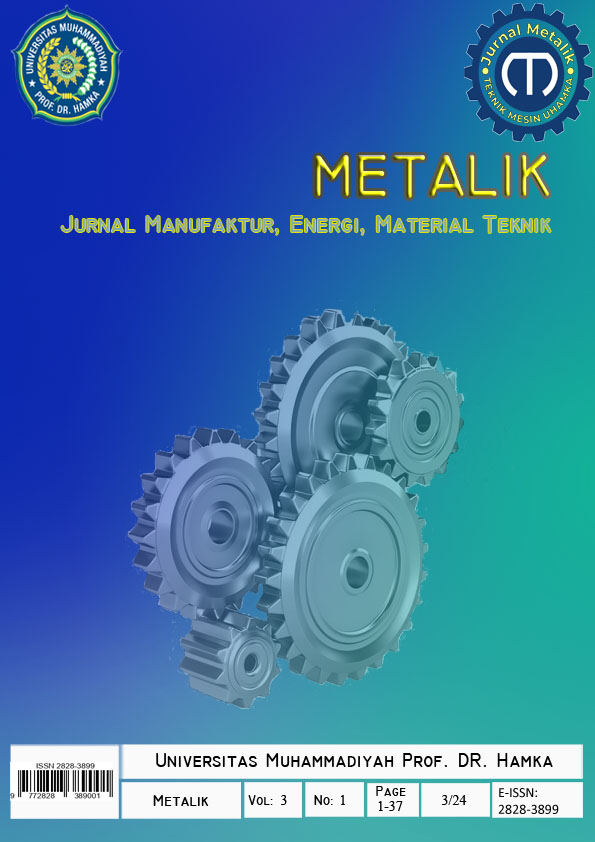Pendayagunaan Energi Matahari sebagai Sumber Energi Listrik Alternatif Menggunakan Generator Termoelektrik
DOI:
https://doi.org/10.22236/metalik.v3i1.15592Keywords:
energi, surya, termoelektrik, generator, atapAbstract
Abstrak
Energi surya adalah energi terbarukan yang potensinya besar untuk dimanfaatkan. Bentuk energi surya yang telah lama dimanfaatkan manusia adalah energi termalnya. Mulai dari pengeraing hasil bumi, perikanan, sampai pemanas air. Sementara termoelektrik adalah material yang berberntuk modul yang dapat mengubah perbedaan temperatur menjadi energi listrik. Kedua hal inilah yang dipadukan dalam penelitian ini. Penelitian memanfaatkan energi surya sebagai sumber energi listrik menggunakan generator termoelektrik. Adapun tujuan penelitian ini adalah untuk mendapatkan daya luaran semaksimal mungkin dari sistem generator termoelektrik yang susunan modulnya dirangkai dengan sambungan seri dan paralel. Dari daya luaran yang dihasilkan akan didapatkan kelayakan generator termoelektrik untuk dijadikan sumber energi pada model bangunan. Metode penelitian yang digunakan adalah eksperimental, yang didahului dengan perancangan dan pembuatan alat penelitian. Model bangunan dirancang sederhana yang berupa kerangka dengan atapnya adalah sistem generator termoelektrik. Variabel dalam penelitian ini adalah susunan rangkaian sambungan modul termoelektrik secara seri dan secara paralel. Data masukan generator termoelektrik adalah intensitas radiasi, kelembaban udara, temperatur (lingkungan, penyerap panas, sisi panas termoelektrik, sisi dingin termoelektrik, sistem pendingin, air pendingin), dan aliran alir; sedangakan data luarannya adalah tegangan listrik dan arus listrik. Hasil penelitian mendapatkan bahwa sistem generator pada atap model bangunan dengan susunan modul termoelektrik dengan rangkaian sambungan seri menghasilkan daya sebesar 1,029 watt. Sementara sistem generator termoelektrik untuk sambungan modul termoelektrik dengan rangkaian sambungan paralel menghasilkan daya sebesar 0,028 watt.
Abstract
Background: Solar energy is a renewable energy that has great potential to be utilized. The form of solar energy that humans have long used is thermal energy. Starting from drying agricultural products, fisheries, to water heaters. Meanwhile, thermoelectrics are materials in the form of modules that can convert temperature differences into electrical energy. These two things are combined in this research. Research utilizes solar energy as a source of electrical energy using a thermoelectric generator. The aim of this research is to obtain the maximum possible output power from a thermoelectric generator system whose modules are assembled using series and parallel connections. From the resulting output power, the suitability of the thermoelectric generator will be obtained to be used as an energy source in building models. The research method used is experimental, which is preceded by designing and manufacturing research tools. The building model is designed simply in the form of a frame with a thermoelectric generator system on the roof. The variables in this research are the arrangement of thermoelectric module connection circuits in series and in parallel. The input data of the thermoelectric generator are radiation intensity, air humidity, temperature (environment, heat absorber, thermoelectric hot side, thermoelectric cold side, cooling system, cooling water), and flow rate; while the output data is electric voltage and electric current. The research results showed that the generator system on the roof of the building model with a thermoelectric module arrangement with a series connection produced 1,029 watts of power. Meanwhile, the thermoelectric generator system for connecting thermoelectric modules with a parallel connection circuit produces 0.028 watts of power
Downloads
References
Asif, M., & Muneer, T. (2010). Solar Thermal Technologies. In B. L. Capehart (Ed.), Encyclopedia of Energy Engineering and Technology - 3 Volume Set (Print Version) (pp. 1321–1330). CRC Press. https://doi.org/10.1201/9780849338960.ch154
Dincer, I., & Midilli, A. (2007). Green Energy. In B. L. Capehart (Ed.), Encyclopedia of Energy Engineering and Technology (pp. 771–786). CRC Press.
Franklin M. Orr, J., & Benson, S. M. (2012). Sustainability and energy conversions. In D.
S. Ginley & D. Cahen (Eds.), Fundamentals of Materials for Energy and Environmental Sustainability (pp. 36–47). Cambridge University Press.
Jager, K., Isabella, O., Smets, A. H. M., van Swaaij, R. A. C. M. M., & Zeman, M. (2014). Solar energy Fundamentals, Technology, and Systems. In Delft University of Technology.
Lee, H. (2010). Heat Sinks , Thermoelectrics , Heat Pipes , Compact Heat Exchangers , and Solar Cells. John Wiley & Sons.
Lewis, N. S. (Ed.). (2005). Basic Research Needs for Solar Energy Utilization. U.S. Department of Energy.
Nolas, G. S., Sharp, J., & Goldsmid, H. J. (2001). Basic Principles and New Materials Developments. Springer-Verlag Berlin Heidelberg. https://doi.org/10.1007/978-3-662- 04569-5
Rifky. (2020). Pengembangan Model Pendingin Kabin City Car Bertenaga Surya Menggunakan Photovoltaics System (PV) dan Thermoelectric Cooler (TEC). Universitas Pancasila.
Rosen, M. A. (2007). Natural Energy versus Additional Energy. In B. L. Capehart (Ed.),
Encyclopedia of Energy Engineering and Technology (pp. 1088–1110). CRC Press.
Terry M. Tritt, Xinfeng Tang, Qingjie Zhang, and W. X. (2012). Solar thermoelectrics: direct solar thermal energy conversion. In Fundamentals of Materials for Energy and Environmental Sustainability (Vol. 5, Issue 4). Materials Research Society.
Vedanayakam, V., & Suvarna, P. (2018). Study Of Thermoelectric Generator In Different Combinations Of Series And Parallel Configurations – Calculation Of Power And Efficiency. 8(7), 30–34. https://doi.org/10.9790/9622-0807033034
Wang, Y. T., Liu, W., Fan, A. W., & Li, P. (2013). Performance comparison between series- connected and parallel-connected thermoelectric generator systems. Applied Mechanics and Materials, 327(June), 327–331. https://doi.org/10.4028/www.scientific.net/AMM.325-326.327
Downloads
Published
How to Cite
Issue
Section
License
Copyright (c) 2024 METALIK : Jurnal Manufaktur, Energi, Material Teknik

This work is licensed under a Creative Commons Attribution-NonCommercial 4.0 International License.
















